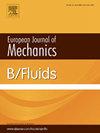Investigation on post-collapse rebound and rebound-induced pulsations of hydraulic cavitation in a Venturi
IF 2.5
3区 工程技术
Q2 MECHANICS
引用次数: 0
Abstract
High-frequency and high-amplitude pulsation characteristics play a significant role in the various negative effects of hydraulic cavitation, but the formation mechanism has not been explored clearly. Addressing this problem, experimental and numerical studies on internal cavitation flow, represented by Venturi cavitation, were conducted. Through high-speed photography and image processing, post-collapse rebound, a rarely reported hydraulic cavitation evolutionary link was demonstrated. Based on a self-developed simplified compressible cavitation algorithm, the evolution and formation of rebound were analyzed, and the formation mechanism of high-frequency and high-amplitude pressure pulsation was further revealed. Also, the effects of compressibility and pressure ratio were studied. The results show that reciprocating rebounds occur after the detached cavity collapses, with the rebound cavity volume successive decreasing. Rebound is the result of pressure wave propagation. The propagation of the cavity collapse-induced peak pressure tends to develop a trough pressure low to saturated vapor pressure, resulting in the post-collapse rebound. Reciprocating rebounds and collapse are key links causing strong cavitation pulsations, especially high-frequency and high-amplitude pulsations. The collapse of the detached cavity and reciprocal rebound cavities within a single evolutionary cycle induced extremely high pressure and multiple high pressures successively, forming the high-frequency and high-amplitude pressure pulsation. Besides, compressibility is the key to the numerical prediction of rebound. The number of rebounds and the volume of the rebound cavity depend on the severity of cavitation.
文丘里液力空化坍塌后回弹及回弹诱发脉动研究
高频、高幅值脉动特性在水力空化的各种负面效应中起着重要作用,但其形成机制尚未得到明确探讨。针对这一问题,开展了以文丘里空化为代表的内部空化流动的实验和数值研究。通过高速摄影和图像处理,崩塌后反弹,证明了很少报道的水力空化进化联系。基于自主开发的简化可压缩空化算法,分析了回弹的演化与形成,进一步揭示了高频高幅值压力脉动的形成机理。同时,研究了压缩率和压比的影响。结果表明:分离空腔坍塌后会出现往复回弹,回弹空腔体积依次减小;回弹是压力波传播的结果。空腔坍缩引起的峰值压力的传播倾向于形成一个低至饱和蒸汽压的槽压力,导致坍缩后反弹。往复反弹和塌陷是产生强空化脉动,特别是高频、高振幅脉动的关键环节。分离腔和互反腔在一个演化周期内的崩塌,相继诱发极高压力和多重高压,形成高频、高振幅的压力脉动。压缩系数是回弹数值预测的关键。反弹的数量和反弹腔的体积取决于空化的严重程度。
本文章由计算机程序翻译,如有差异,请以英文原文为准。
求助全文
约1分钟内获得全文
求助全文
来源期刊
CiteScore
5.90
自引率
3.80%
发文量
127
审稿时长
58 days
期刊介绍:
The European Journal of Mechanics - B/Fluids publishes papers in all fields of fluid mechanics. Although investigations in well-established areas are within the scope of the journal, recent developments and innovative ideas are particularly welcome. Theoretical, computational and experimental papers are equally welcome. Mathematical methods, be they deterministic or stochastic, analytical or numerical, will be accepted provided they serve to clarify some identifiable problems in fluid mechanics, and provided the significance of results is explained. Similarly, experimental papers must add physical insight in to the understanding of fluid mechanics.

 求助内容:
求助内容: 应助结果提醒方式:
应助结果提醒方式:


